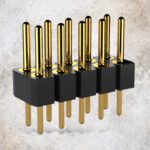Solid-Contact Connectors for Higher Power Density
An age-old connector technology is being “rediscovered” as a better solution for power connector density issues.
 The quest to manufacture electronics in smaller and smaller packages continues as consumer demand for palm-sized computers and pen-sized communications equipment grows. The Holy Grail seems to be a computer on a pinhead and entertainment electronics one can slip in his or her wallet. These goals are difficult though, for materials have limitations and manufacturing has its constraints. The electronic power supply industry and its related power interconnects are no exception to these demands and inherent limitations.
The quest to manufacture electronics in smaller and smaller packages continues as consumer demand for palm-sized computers and pen-sized communications equipment grows. The Holy Grail seems to be a computer on a pinhead and entertainment electronics one can slip in his or her wallet. These goals are difficult though, for materials have limitations and manufacturing has its constraints. The electronic power supply industry and its related power interconnects are no exception to these demands and inherent limitations.
Return to an Age-Old Technology
In power supplies, there is a growing need for more power to be sent through smaller and smaller connectors, as tinier yet more powerful microprocessors and other components demand increased current. As more current is sent through smaller areas, more heat is generated. Previously, the best way to reduce heat was to add space, but that is no longer preferable. To further complicate the situation, agencies such as UL and TUV regulate connector parameters (creepage and clearance distances, for example), to help ensure safety, but, alas, this further impedes the pursuit of downsizing.
For the past 40 years, the interconnect world has been highly influenced by “stamped” contact technology connectors. This technology has helped to make mass-produced electronic goods affordable. To solve the problem of high-current distribution, stamped-contact connector manufacturers have offered what has become known as the blade connector, which uses power contacts with large flat sections of folded sheet metal. Though the blade connector offers attractive costing, it is not particularly dense or small in size.
Another connector technology, an age-old one, is now being “rediscovered” as a better solution for solving power connector density issues, and, when additional factors are considered, it can prove to be lower in cost as well. This technology is the solid-machined or precision-machined contact connector. Solid-machined contacts, when used with advanced mating area designs, offer up to two times more power density than a blade connector. This means that a solid-contact power connector can transfer two times more amperage than a same-sized blade connector.
Origins of Solid-Contact Connectors

(Photo courtesty of Positronic)
Solid-contact connectors have been in use for more than 70 years. They utilize contacts “turned” or machined on precision lathes, equipment initially invented for the Swiss watch industry. Solid contacts are just that – solid metal, typically made of brass and bronze alloys.
When stamped-contact connectors became more popular in the 1970s, solid-contact connectors were often relegated to higher reliability applications, such as those found in the medical or aerospace industries. But solid-contact connectors, because of their unique capabilities, have never totally been forgotten for use in electronic power applications.
Advantages of Solid Contacts
The advantage of solid contacts, when contrasted to those of stamped construction, is that solid contacts offer a solid mass for the transfer of current. There is more solid metal in the spatial contact area in contrast to stamped-contact products. Mass alone, though, does not necessarily ensure a superior power contact. Interconnect designers must also provide a male-to-female mating system that ensures a large surface area of “embrace” or surface-to-surface connection. This is key to maintaining low contact-resistance levels and enabling maximum current-carrying capacity. Solid-contact designs can offer contact resistances that are a fraction of those found in common stamped-contact connectors. This is fundamental to understanding why solid-contact connectors can transfer two times more power than blade connectors.
Materials, too, can make a difference in the performance of a power contact. If more power density is desired, a designer can use super-conductivity alloys. Current-carrying capacity and density is increased, but so also is the end price.
A superb contact size for power distribution is the size-16 solid contact (1.58mm mating diameter). This contact can be rated up to 23 amperes (30°C temperature rise) of capacity depending on the contact material selected, connector plastics in use, clearance distances between contacts, and the temperature rise allowed. In a blade connector occupying 315mm2, 90 amperes are possible. When using size-16 solid contacts with high-conductivity material, in a 319mm2 area, 192 amperes of current are possible. That translates to two times better power density (see Figure 1).

Another aspect of the size-16 power contact is potentially beneficial: If a designer is channeling 200 amperes onto a printed circuit board via the connector, connectors using size-16 printed circuit board-mount contacts can offer a more even distribution of power across the board, enabling easier circuitry layout and better heat dissipation.
Cable Connector Applications
In cable connector applications, additional advantages are seen. Solid contacts again enable the power system designer to use a smaller connector, as fewer contacts are needed to meet the power requirement. Continuing this train of thought, less wiring is then required, less material needed, less assembly time required, and then finally, less points for potential harness failure.
The power density benefits of solid contacts, as I mentioned before, are not unknown to some designers involved with power supply interconnections. In 1999, one industry association, PICMG (PCI Industrial Computer Manufactures Group), was faced with the predicament of getting more power into its next-generation 3U- and 6U-sized power supply standard. The previously used DIN-style power connector offered insufficient power capacity. A same-sized but higher-power connector was needed. The solution, after much development, was to maintain the Euro-DIN form factor but to create a new connector that utilized solid size-16 power contacts. A 47-contact mixed power/signal connector was devised that can carry almost 400 amperes: 20 DC contacts rated to 16 amperes (30°C rise); three AC contacts rated to 23 amperes (30°C rise); and 24 signal contacts. The connector is defined in the PICMG 2.11 power interface specification and has become a worldwide industry standard spawning a whole series of mother-daughterboard power connectors as well as copies.
Other similar developments are occurring. The common four-position “disk drive” connector now also has a same-sized alternative with solid contacts and triple the current-carrying capacity. New power connector designs should continue in this direction, as density issues infiltrate more and more areas of electronics.
Durability
One last feature of the solid contact is noteworthy, especially since so many power supplies these days are redundant types, rack-mounted and requiring blind mating connectors: Solid contacts are more durable and less prone to bending and damage. Possible contact harm due to misalignment is a reality when blind mating is involved, so using a more durable contact, as is offered through solid-contact technology, versus stamped technology, is a smart way to further ensure system reliability and defend against future safety issues.
The benefits of solid-contact interconnects are many, and they are accentuated in the power supply world. The solid mass they offer assists in increasing power density and defends against potential damage of mating misalignment. But the solid mass is not enough, so connector designers engineer solid contacts with an enlarged area of “embrace” to increase the surface area of the male-to-female connection. The result is a truly superior power interconnection, with power connectors having up to two times more power density than common blade connectors. Although prices are sometimes higher for this old but now seemingly advanced interconnection technology, prices can prove to be less, especially if smaller packaging is really an issue and reliability important. If size reduction is key to a system design and power connectors are part of that issue, solid-machined power contacts clearly offer the highest-density solution, if not best all-around technical choice.
Author William D. Gentry is president of Positronic Asia Pte Ltd.






